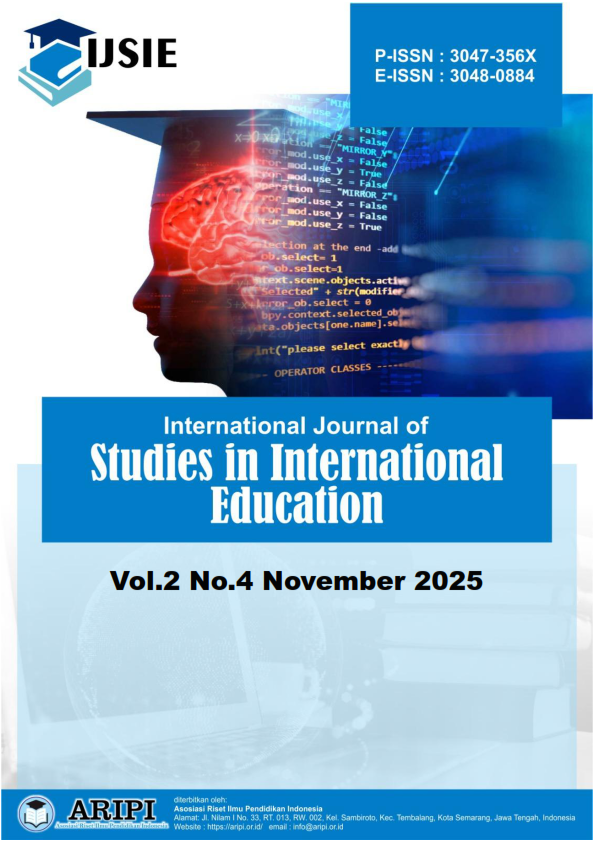The Effectiveness of Using the Telegram Application in Learning the Malay Culture Course at Universitas Riau
DOI:
https://doi.org/10.62951/ijsie.v2i4.416Keywords:
Telegram, Learning Media, Malay Culture, Effectiveness, University of RiauAbstract
This study aims to analyze the effectiveness of using the Telegram application as an innovative digital learning medium in the Malay Culture course at Universitas Riau. The integration of technology in education has become essential in enhancing learning outcomes and student engagement, particularly in cultural-based subjects that require active interaction and collaboration. This research employed a qualitative descriptive method, with data collected through questionnaires, interviews, and documentation. The results indicate that the Telegram application provides significant benefits in facilitating the learning process. It enables efficient distribution of learning materials, smooth communication between lecturers and students, and the creation of interactive discussion spaces. Moreover, Telegram’s features—such as group chats, file sharing, and polls—encourage student participation, improve accessibility to resources, and foster collaborative learning. The study also found that students felt more motivated, independent, and responsible in managing their learning activities through this platform. Overall, the use of Telegram has proven to be effective, practical, and adaptable in supporting the teaching and learning process of the Malay Culture course. Therefore, it is recommended that Telegram be utilized not only in cultural studies but also across other academic disciplines to enhance the quality of online and blended learning environments.
References
Aladsani, H. K. (2021). University students’ use and perceptions of Telegram to promote effective educational interactions: A qualitative study. International Journal of Emerging Technologies in Learning (IJET), 16(9), 182–197. https://doi.org/10.3991/ijet.v16i09.19281
Alhabib, T. J., Cahyani, I., & Saadie, M. M. (2020). Pemanfaatan media Telegram pada pembelajaran menulis cerpen [The utilization of Telegram in short story writing learning]. Seminar Internasional Riksa Bahasa, 493–501. https://proceedings.upi.edu/index.php/riksabahasa/article/view/1386/1262
Barokah, E. (2021). Penerapan penggunaan Telegram dalam pembelajaran bahasa Indonesia meningkatkan kemampuan dan hasil belajar pada teks hikayat [The application of Telegram in Indonesian language learning to improve competence and learning outcomes in hikayat texts]. Jurnal Pendidikan dan Kewirausahaan, 9(2), 309–325. https://doi.org/10.47668/pkwu.v9i2.248
Fitriansyah, F., & Aryadillah. (2020). Penggunaan Telegram sebagai media komunikasi dalam pembelajaran online [Using Telegram as a communication medium in online learning]. Cakrawala Jurnal Humaniora Bina Sarana Informatika, 20(2), 111–117. https://doi.org/10.31294/jc.v20i2.8935
Kristanto, A., Aisyah, S., Febrianti, F., Dewi, U., Hidayati, A., Budi, U. L., & Susarno, L. H. (2024). Standardization in digital teaching and learning in higher education: Indonesia evidence. Journal of Education Technology, 8(2), 257–263. https://doi.org/10.23887/jet.v8i2.70548
LPPMP UNRI. (2020). Keputusan Rektor Universitas Riau tentang penetapan budaya akademik Universitas Riau (SK) [Decision of the Chancellor of Riau University regarding the determination of Riau University's academic culture]. https://www.ppm-lppmp-unri.web.id/data_web_ppm/surat/SK.%20Penetapan%20Budaya%20Akademik%20Universitas%20Riau.pdf
Marda, W., & Hendriana, H. (2023). The effectiveness of Telegram as a medium of learning during the pandemic in Indonesian subjects in SMPN 6 Karawang Barat school year 2019–2020. Journal of Language Education Research (JLER), 6(1), 27–34. https://doi.org/10.22460/jler.v6i1.10423
Mariyah, Y., Budiman, A., Rohayani, H., & Audina, W. (2021). Meningkatkan motivasi belajar siswa melalui pemanfaatan media audio visual: Studi eksperimen dalam pembelajaran tari [Improving student learning motivation through the utilization of audio visual media: An experimental study in dance learning]. Journal of Education, Humaniora and Social Sciences (JEHSS), 4(2), 959–967. https://doi.org/10.34007/jehss.v4i2.778
Maulidiyah, I. (2022). Efektivitas aplikasi Telegram sebagai media pembelajaran bahasa Indonesia [The effectiveness of Telegram application as a medium for teaching Indonesian language]. Kwangsan: Jurnal Teknologi Pendidikan, 10(1), 75–88. https://jurnalkwangsan.kemdikbud.go.id/index.php/jurnalkwangsan/article/view/717
Miles, M. B., & Huberman, A. M. (1994). Qualitative data analysis: An expanded sourcebook. SAGE Publications.
Moleong, L. J. (2018). Metodologi penelitian kualitatif. PT Remaja Rosdakarya.
Molina, O. E. (2022). The effects of WhatsApp and Telegram on student engagement: An analysis from the mixed-methods approach. Education Research International, 2022(1). https://doi.org/10.1155/2022/2881404
Munir. (2017). Pembelajaran digital. Alfabeta.
Puniatmaja, G. A., Parwati, N. N., Tegeh, I. M., & Sudatha, I. G. W. (2025). Development of Indonesia’s digital education platform for learning: Unified model. International Journal of Information and Education Technology, 15(5), 1045–1060. https://www.ijiet.org/vol15/IJIET-V15N5-2309.pdf
Sugiyono. (2017). Metode penelitian kuantitatif, kualitatif, dan R&D. Alfabeta.
Downloads
Published
How to Cite
Issue
Section
License
Copyright (c) 2025 International Journal of Studies in International Education

This work is licensed under a Creative Commons Attribution-ShareAlike 4.0 International License.




